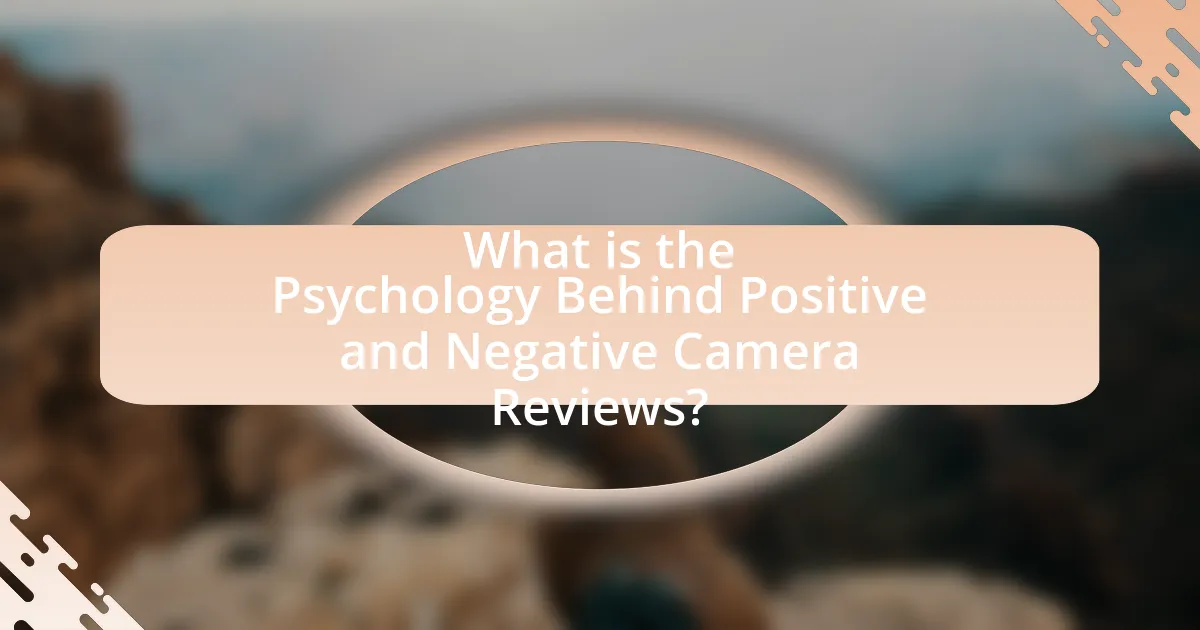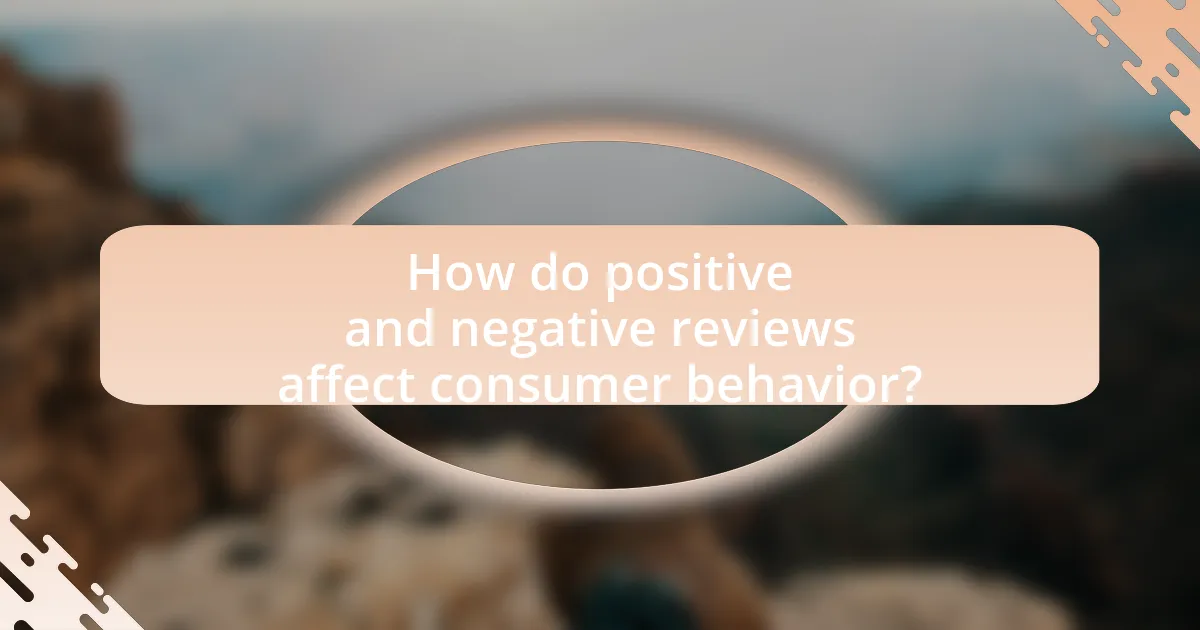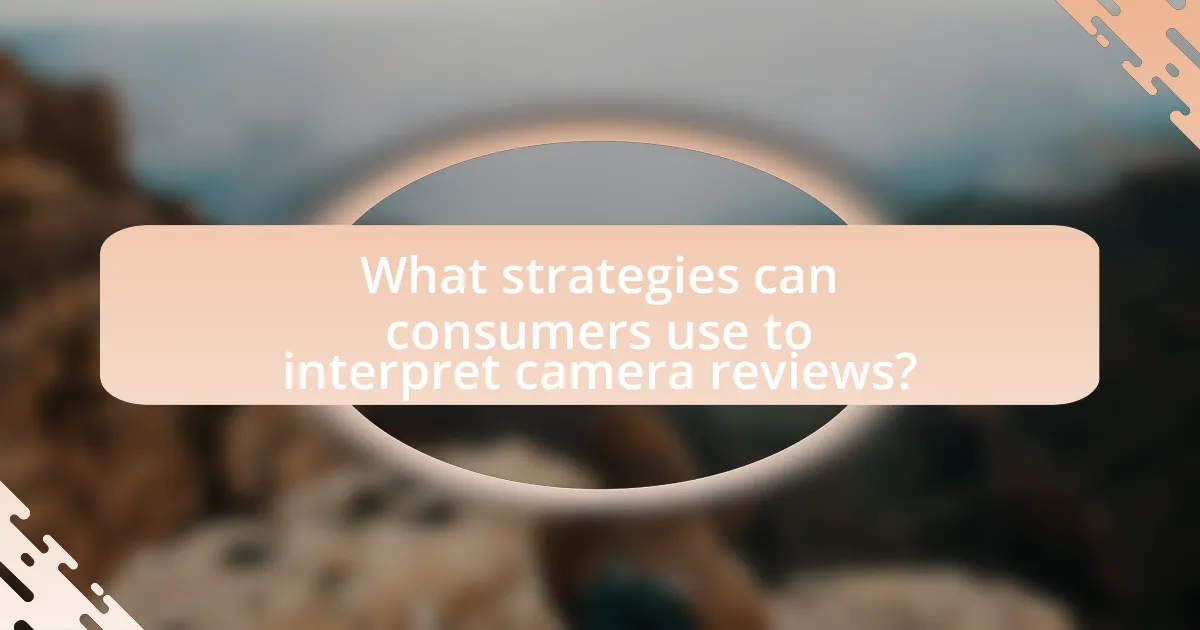The article examines the psychology behind positive and negative camera reviews, highlighting how cognitive biases and emotional responses shape consumer perceptions. It discusses the impact of factors such as the halo effect, loss aversion, and social proof on review writing and interpretation. Key themes include the motivations behind leaving reviews, the influence of emotions on perceived camera performance, and the common complaints and praises found in consumer feedback. Additionally, the article outlines strategies for consumers to effectively evaluate reviews, identify bias, and make informed purchasing decisions based on a comprehensive understanding of both expert and user-generated content.

What is the Psychology Behind Positive and Negative Camera Reviews?
The psychology behind positive and negative camera reviews is rooted in cognitive biases and emotional responses that influence consumer perceptions. Positive reviews often evoke feelings of trust and satisfaction, leading potential buyers to feel more confident in their purchasing decisions, as supported by the halo effect, where favorable impressions in one area (like a review) enhance perceptions in others (such as product quality). Conversely, negative reviews can trigger fear of loss and regret, causing potential buyers to reconsider their choices, a phenomenon explained by loss aversion, which suggests that losses weigh heavier on individuals than equivalent gains. Research indicates that consumers are more likely to trust reviews that reflect a balance of both positive and negative feedback, as this perceived authenticity enhances credibility.
How do psychological factors influence camera reviews?
Psychological factors significantly influence camera reviews by shaping reviewers’ perceptions and emotional responses to products. For instance, cognitive biases such as confirmation bias lead reviewers to favor information that supports their initial beliefs about a camera, while the halo effect can cause them to rate a camera more favorably based on its brand reputation or design aesthetics. Additionally, social proof, where individuals look to the opinions of others, can sway reviewers to align their assessments with popular sentiments, impacting the overall tone of the reviews. Research indicates that emotional engagement, such as excitement or disappointment, can also color the review process, as seen in studies showing that emotionally charged experiences lead to more extreme evaluations.
What role does cognitive bias play in shaping reviews?
Cognitive bias significantly influences the formation of reviews by affecting how individuals perceive and interpret their experiences. For instance, confirmation bias leads reviewers to focus on information that supports their pre-existing beliefs about a product, while ignoring contradictory evidence. Research by Nickerson (1998) highlights that this bias can skew the overall assessment of a product, resulting in reviews that may not accurately reflect its true quality. Additionally, the halo effect can cause reviewers to let their overall impression of a brand or previous experiences with similar products color their evaluations, further distorting the review process. These biases collectively shape the narrative around products, impacting consumer decisions and market perceptions.
How do emotions affect the perception of camera performance?
Emotions significantly influence the perception of camera performance by shaping users’ experiences and evaluations. Positive emotions, such as excitement or satisfaction, can lead to a more favorable assessment of a camera’s capabilities, often resulting in higher ratings and positive reviews. Conversely, negative emotions, like frustration or disappointment, can skew perceptions, causing users to focus on flaws and underappreciate the camera’s strengths. Research indicates that emotional responses can alter cognitive processing, leading individuals to prioritize emotional experiences over objective performance metrics. For instance, a study published in the Journal of Consumer Research by authors like J. M. M. van der Lans and M. A. W. van der Laan found that emotional states significantly impact product evaluations, reinforcing the idea that emotions play a crucial role in how camera performance is perceived.
Why do consumers leave positive or negative reviews?
Consumers leave positive or negative reviews primarily to express their satisfaction or dissatisfaction with a product or service. Positive reviews often stem from a fulfilling experience, where consumers feel that their expectations were met or exceeded, leading them to share their appreciation with others. Conversely, negative reviews typically arise from unmet expectations, poor quality, or unsatisfactory customer service, prompting consumers to warn others about their experience. Research indicates that approximately 70% of consumers trust online reviews as much as personal recommendations, highlighting the influence of these reviews on purchasing decisions.
What motivates users to share their experiences with cameras?
Users are motivated to share their experiences with cameras primarily to express their opinions and influence others’ purchasing decisions. This behavior is driven by a desire for social validation, as individuals seek acknowledgment and engagement from their peers. Research indicates that 70% of consumers trust online reviews, highlighting the impact of shared experiences on potential buyers. Additionally, sharing personal experiences allows users to contribute to a community of enthusiasts, fostering a sense of belonging and expertise.
How does social influence impact review writing?
Social influence significantly impacts review writing by shaping individuals’ perceptions and opinions based on the feedback and behaviors of others. When consumers observe positive or negative reviews from peers, they are likely to align their own reviews with the prevailing sentiment, a phenomenon supported by social proof theory, which suggests that people tend to follow the actions of others in uncertain situations. Research by Cialdini et al. (2006) indicates that individuals are more inclined to write favorable reviews when they see a majority of positive feedback, reinforcing the idea that social validation plays a crucial role in the review process.
What are the common themes in positive and negative camera reviews?
Common themes in positive and negative camera reviews include image quality, ease of use, and customer service. Positive reviews often highlight superior image clarity, vibrant colors, and user-friendly interfaces, indicating satisfaction with the camera’s performance. Conversely, negative reviews frequently criticize poor low-light performance, complicated settings, and unresponsive customer support, reflecting dissatisfaction. These themes are consistently observed across various review platforms, demonstrating their significance in consumer decision-making.
What features do reviewers typically praise in cameras?
Reviewers typically praise cameras for their image quality, autofocus performance, and low-light capabilities. High image quality is often highlighted due to its impact on overall user satisfaction, with many reviewers noting that sharpness, color accuracy, and dynamic range are crucial for professional and amateur photographers alike. Autofocus performance is frequently commended, especially in fast-paced shooting scenarios, where quick and accurate focusing can significantly enhance the shooting experience. Additionally, low-light capabilities are often celebrated, as cameras that perform well in dim conditions allow for greater creative flexibility, making them more appealing to users who shoot in various environments. These features are consistently mentioned in reviews, reinforcing their importance in the overall evaluation of camera performance.
What common complaints arise in negative camera reviews?
Common complaints in negative camera reviews include poor image quality, slow autofocus, and inadequate low-light performance. Reviewers frequently express dissatisfaction with the camera’s inability to capture sharp images in various lighting conditions, which undermines the overall user experience. Additionally, many users report frustration with the camera’s autofocus system, citing delays or inaccuracies that hinder capturing fast-moving subjects. Furthermore, complaints about battery life and the complexity of the user interface are also prevalent, as these factors can significantly impact usability and convenience. These issues are often highlighted in reviews across multiple platforms, indicating a consistent pattern of dissatisfaction among users.

How do positive and negative reviews affect consumer behavior?
Positive reviews significantly enhance consumer behavior by increasing trust and perceived value, leading to higher purchase intentions. Research indicates that 84% of consumers trust online reviews as much as personal recommendations, demonstrating the powerful influence of positive feedback on decision-making. Conversely, negative reviews can deter potential buyers, as 94% of consumers report avoiding a product after reading a negative review. This dual impact illustrates how both types of reviews shape consumer perceptions and choices, ultimately affecting sales and brand reputation.
What impact do reviews have on purchasing decisions?
Reviews significantly influence purchasing decisions by shaping consumer perceptions and trust. Research indicates that approximately 84% of people trust online reviews as much as personal recommendations, highlighting their critical role in the decision-making process. Positive reviews can enhance a product’s credibility, leading to increased sales, while negative reviews can deter potential buyers, as 79% of consumers report avoiding products with poor ratings. This demonstrates that reviews serve as a vital source of information that directly impacts consumer behavior and purchasing choices.
How do positive reviews enhance consumer trust?
Positive reviews enhance consumer trust by providing social proof that a product or service meets or exceeds expectations. When potential buyers see favorable feedback from previous customers, they are more likely to perceive the offering as reliable and of high quality. Research indicates that 79% of consumers trust online reviews as much as personal recommendations, highlighting the significant impact of positive testimonials on purchasing decisions. This trust is further reinforced by the sheer volume of positive feedback, as a higher number of favorable reviews correlates with increased consumer confidence in the brand or product.
What are the consequences of negative reviews on sales?
Negative reviews significantly decrease sales by influencing potential customers’ perceptions and decisions. Research indicates that 86% of consumers read reviews for local businesses, and 95% of them read negative reviews before making a purchase. A study by Harvard Business School found that a one-star increase in Yelp ratings can lead to a 5-9% increase in revenue. Conversely, negative reviews can deter customers, leading to reduced trust and lower conversion rates. Therefore, the presence of negative reviews directly correlates with diminished sales performance.
How do reviews shape brand perception?
Reviews significantly shape brand perception by influencing consumer trust and decision-making. Positive reviews enhance a brand’s credibility and attract potential customers, while negative reviews can deter purchases and damage reputation. Research indicates that 79% of consumers trust online reviews as much as personal recommendations, highlighting their impact on consumer behavior. Furthermore, a study published in the Journal of Marketing Research found that a one-star increase in a restaurant’s Yelp rating can lead to a 5-9% increase in revenue, demonstrating the tangible effects of reviews on brand perception and financial performance.
What is the relationship between review sentiment and brand loyalty?
Review sentiment directly influences brand loyalty, as positive reviews typically enhance customer trust and satisfaction, leading to repeat purchases. Research indicates that consumers are more likely to remain loyal to brands that receive favorable reviews; for instance, a study published in the Journal of Marketing Research found that a one-point increase in a product’s rating can lead to a 10-20% increase in sales, demonstrating the strong correlation between positive sentiment and customer retention. Conversely, negative reviews can diminish brand loyalty, as they often lead to decreased trust and increased likelihood of switching to competitors.
How can brands respond to negative reviews effectively?
Brands can respond to negative reviews effectively by acknowledging the issue, apologizing sincerely, and offering a solution. Acknowledgment shows the customer that their feedback is valued, while a sincere apology can help to diffuse tension and demonstrate empathy. Offering a solution, such as a refund or replacement, addresses the customer’s concern directly and can lead to a resolution. Research indicates that 70% of customers who receive a response to their negative review are likely to change their opinion about the brand positively, highlighting the importance of timely and thoughtful engagement.

What strategies can consumers use to interpret camera reviews?
Consumers can use several strategies to interpret camera reviews effectively. First, they should compare multiple reviews from different sources to identify common themes and discrepancies, as this helps to mitigate bias from individual reviewers. For instance, a study by the Journal of Consumer Research indicates that consumers who consult multiple reviews are more likely to make informed decisions. Additionally, focusing on specific criteria such as image quality, usability, and durability allows consumers to align reviews with their personal needs. Analyzing the reviewer’s background and expertise can also provide context; for example, a review from a professional photographer may carry more weight than one from a casual user. Lastly, paying attention to the review date is crucial, as technology evolves rapidly, and older reviews may not reflect the latest models or features.
How can consumers identify bias in camera reviews?
Consumers can identify bias in camera reviews by analyzing the language used, the reviewer’s background, and the consistency of the review with other sources. Biased reviews often contain overly positive or negative language that lacks specific examples or technical details, indicating a potential lack of objectivity. Additionally, if the reviewer has affiliations with brands or receives compensation, this can influence their perspective. Cross-referencing reviews from multiple sources can reveal discrepancies, helping consumers discern more balanced opinions. Research shows that reviews with extreme sentiments are often less reliable, as they may reflect personal biases rather than factual assessments.
What signs indicate a review may be unreliable?
Signs that indicate a review may be unreliable include overly vague language, lack of specific details, and an absence of balanced perspectives. Reviews that use extreme language, such as “best ever” or “worst ever,” often lack nuance and critical analysis, suggesting bias. Additionally, if a review is excessively positive or negative without providing concrete examples or evidence, it raises questions about its authenticity. Reviews that are posted in clusters, either all positive or all negative, may indicate manipulation or incentivization, further undermining their reliability.
How can consumers differentiate between subjective and objective reviews?
Consumers can differentiate between subjective and objective reviews by analyzing the language and content of the reviews. Objective reviews focus on measurable aspects such as specifications, performance metrics, and factual information, while subjective reviews express personal opinions, feelings, and experiences. For example, an objective review might state that a camera has a resolution of 24 megapixels and a battery life of 500 shots, whereas a subjective review may describe the camera as “amazing” or “disappointing” based on the reviewer’s personal experience. This distinction allows consumers to assess the reliability of the information presented, enabling informed purchasing decisions.
What best practices should consumers follow when reading reviews?
Consumers should verify the credibility of reviews by checking the reviewer’s profile and history. This practice ensures that the feedback comes from genuine users rather than potential fake accounts. Additionally, consumers should look for patterns in reviews, such as recurring themes in both positive and negative feedback, which can indicate consistent product performance. It is also beneficial to read a mix of reviews, including both high and low ratings, to gain a balanced perspective. Research shows that consumers are more likely to trust reviews that include detailed descriptions and specific experiences, as these provide context and authenticity. By following these best practices, consumers can make more informed decisions based on reliable information.
How can consumers balance multiple reviews for informed decisions?
Consumers can balance multiple reviews for informed decisions by analyzing the overall sentiment and credibility of the reviews. This involves aggregating ratings, identifying common themes in feedback, and considering the source of each review. Research indicates that consumers often rely on the average rating and the number of reviews to gauge product quality, with a study showing that products with a higher number of reviews tend to be perceived as more trustworthy. Additionally, examining both positive and negative reviews helps consumers understand potential strengths and weaknesses, allowing for a more nuanced decision-making process.
What tools or resources can assist in evaluating camera reviews?
Tools and resources that assist in evaluating camera reviews include comparison websites, expert review platforms, and user-generated content forums. Comparison websites like DPReview and Camera Decision provide side-by-side specifications and performance metrics, enabling users to assess different camera models effectively. Expert review platforms such as CNET and TechRadar offer in-depth analyses and ratings based on rigorous testing, which helps consumers understand the strengths and weaknesses of various cameras. Additionally, user-generated content forums like Reddit and photography-specific communities allow potential buyers to read real-world experiences and opinions, providing a broader perspective on camera performance and reliability. These resources collectively enhance the evaluation process by offering diverse viewpoints and detailed information.
What are the key takeaways for understanding camera reviews?
Key takeaways for understanding camera reviews include recognizing the importance of specifications, user experience, and expert opinions. Specifications such as sensor size, lens quality, and ISO performance directly impact image quality and usability. User experience highlights practical aspects like ergonomics and interface, which can significantly influence satisfaction. Expert opinions provide insights based on extensive testing and comparisons, often revealing strengths and weaknesses that may not be apparent to casual users. Understanding these elements helps consumers make informed decisions based on both technical data and real-world performance.